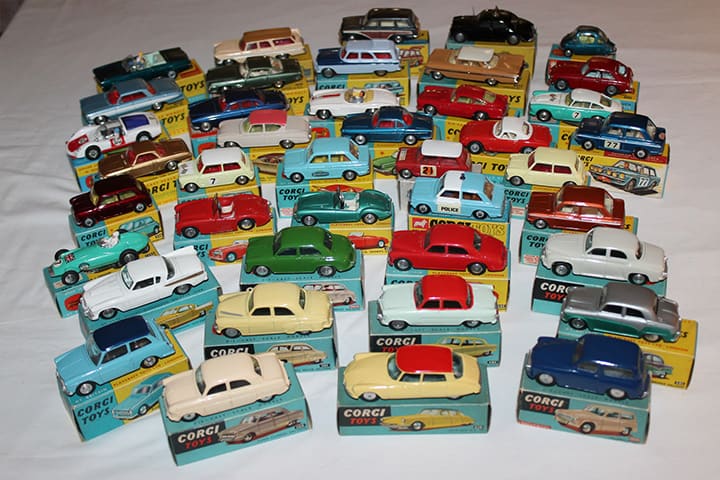
Origins prior to Corgi Toys
The origins of Corgi Toys started long before the first model was produced in 1956. The vision came from a German immigrant named Philipp Ullman who arrived in the UK in 1932-33. Ullmann was already an expert toy manufacturer back in his homeland. Previous articles have been written informing us that he had established a toy business in 1912 in Nuremburg called Tipp & Company; also known as Bechmann & Ullmann. Ullman travelled to South Africa and stayed for around 7 years developing new skills which would hold him in good stead in the future when he moved to England.
Just before leaving Germany for England Ullman who was involved with the company Tippco, also based in Nuremberg, which manufactured quality tin plate toys with excellent lithography. Ullman came to England establishing a base in Northampton and was joined by previous colleagues Frederick Handl and Lionel Gordon where he became a leading director and influence at the Mettoy Co Ltd. In 1934 a significant event took place where a long term fellow director from the past arrived from Germany Arthur Katz. This continued to be a long term partnership which operated right through to Ullmann’s death in 1971.
Before the brand ‘Corgi’ was used in 1956 the company Mettoy looked to expand their toy range and in 1948 they saw their first production models made from aluminium. A smaller range of mazac diecast vehicles followed in 1950. This range ceased in 1954 and was replaced by some plastic models.
Corgi Toys
The directors were very aware that the diecast toy market was booming and one company in particular with a brand called Dinky Toys was very successful. The directors realized that they had to capture a strong share of this market but also had to have a key selling point as a new brand. The slogan became ‘The ones with windows’. All Corgi toys right from the first model in 1956 was issued with attractive moulded window encasement. They quickly established themselves for the next two decades as a very innovative brand often the first to provide a new idea whether it was internal seating, plastic moulds or features such as opening bonnets, boots or doors and windows. The innovations became almost endless. The first model with an opening bonnet was issued in 1960 the 216 Aston Martin DB4 and this, though produced mainly in two bright colours of red and yellow, created a number of variations with casting and wheels changing. Over 1,000,000 units were sold and in 1962 the Aston Martin DB4 Competition finished in green and white was released proving a further 500,000 sales. This model led on to 1965 when the casting was adjusted to make way for the biggest selling Corgi model of all time The James Bond Aston Martin initially in Gold representing the movie ‘Goldfinger’ but eventually changing to silver and then enlarging the casting for future releases on a similar James Bond theme.
By the Mid 60’s Corgi were probably more successful than the Dinky brand. They were creating huge sales and were exporting throughout the world. The 241 Ghia L6.4 which was released in several colours sold 1,750,000 units. This model had an opening boot, bonnet and doors, had a Corgi dog on the back window shelf and jewelled headlights with all round suspension. Corgi also appeared to concentrate often on models that had not been issued by Dinky creating a wider range of choice and less competition for a child after a particular model. They were ahead of the game when it came to TV and film issues producing phenomenal success with models such as Batmobile, The Thrushbuster from Man From Uncle and Noddy and friends the list is almost endless. The Company also covered all model avenues whether Military, rescue and emergency though not as intensive as Dinky at markets such as ships , trains and aeroplanes.
However one area does require a special mention as it has become a significant collectors paradise and that is ‘Gift sets’ Whether a full play scene such as the GS15 Silverstone racing car
set with several models and playmat or car transporter sets with many various options or smaller sets such as a model and boat, these have become a real hub of the collecting world. I should also mention that shop keepers promotional stands, banners, headboards you name it have become so sought after that I am sure many a shopkeeper looks back and thinks ‘Why did I throw that item in the bin’.
Mettoy also sought to compete with Matchbox who were leaders in miniature diecast production. In 1964 they commenced a smaller size diecast model called the Husky’ range which ran until 1969 quickly followed in 1970 by ‘Corgi Juniors’ which finished in 1983.
All good things come to an end
In 1983 Mettoy who by this time were recording seven figure annual losses called in the receivers and their Northampton plant was closed recording up towards 100 staff losses. This was submitted by director Stephen Hanson and was submitted on 17 April 1984. This statement can be viewed in ‘The Great book of Corgi’ by Marcel R. Van Cleemput.
Literature
The most extensive information can be found from ‘The Great Book Of Corgi Toys’ a large manual book. Other notable books I have enjoyed are by;
Mike Richardson named ‘Collecting Corgi
David Cooke, simply called ‘Corgi Toys’ first published in 2011.
Also worth a read is the history on Corgi from the official Corgi website.